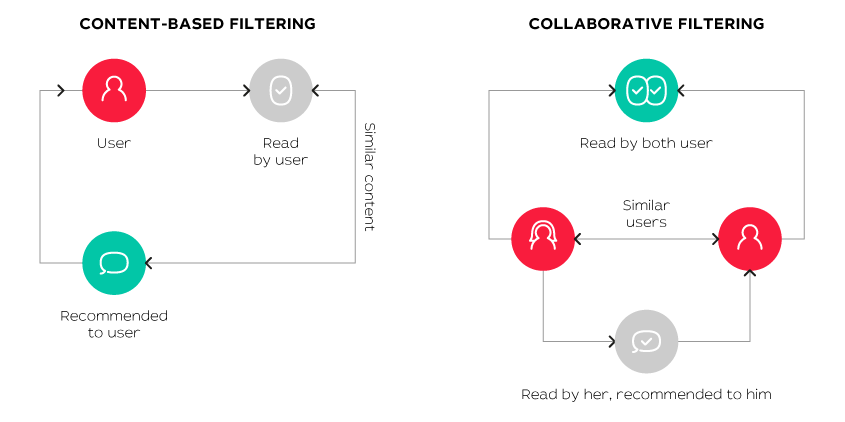Product request
You are looking for a solution:
Select an option, and we will develop the best offer
for you
Neural network “telepathy”: how personalized recommendations help viewers and operators

American magazine Time named 2020 the worst year ever, but it’s not true for the major streaming giants: Netflix, Amazon, and Disney stocks beat all-time records in 2020 and continue to grow.
Being in self-isolation, people started subscribing to various video services and immediately faced a new problem: what to watch? Earlier, when choosing content, people were guided by the selections from the themed portals and friends’ recommendations. These sources, however, don’t take into account the individual preferences of each user, thus leading to a paradox: searching for content takes much more time than actual viewing.
Streaming services solved this issue by offering personalized content recommendations. In this article, we will detail how these systems work and why operators need them.
Basic principles of building recommendation systems
Recommendation systems suggest movies and TV series that may be of interest to a viewer. There are four main approaches to building recommendation engines:
- Content-based filtering
- Collaborative filtering

- Knowledge-based filtering
- Hybrid filtering

Let’s take a closer look at the particulars of each approach.
Content-based filtering
This method is based on finding the common attributes of different content. For example, movie recommendations are often based on characteristics like director, cast, genre, and duration. Some systems also analyze the movie descriptions for TF-IDF evaluation (how important the certain word is in the context of the document).
The goal of the content-based method is to create a profile of each item to search for matches afterward. So, for example, once you’ve watched ‘The Avengers,’ the recommendations for you will include other Marvel Cinematic Universe movies, movies featuring Robert John Downey Jr., and works by Joss Whedon.
This approach has both advantages and disadvantages :
Advantages |
Disadvantages |
Recommendations don’t depend on other users’ data. |
When forming groups of similar items, the system limits the recommendations of other content. This leads to a “filter bubble.” |
There is no “cold start” problem for the new movies because their main attributes are readily known. |
If the information about the products is scant, they will be much harder to group, thus resulting in reduced recommendation quality. |
Collaborative filtering
Collaborative filtering offers recommendations based on feedback from users having similar interests and behavior.
For example, the system should decide whether or not to recommend the ‘Rick and Morty’ series to User A. The algorithm will “scan” the database—searching for the viewers who assessed this content as positive—and form a preference matrix. In the table below, each line shows user feedback, while each column represents a movie. The system makes recommendations looking for similarities in this table.

Collaborative filter algorithm
In our example, User A has more common preferences with User D. The system concludes the following: if User D rated the ‘Rick and Morty’ series highly, then it could be recommended to User A as well.
Element-based collaborative filtering
This filtering type uses movie ratings rather than profile data. For example, if most fans of ‘How I Met Your Mother’ also rated ‘The Big Bang Theory’ highly, then the latter may be recommended to everyone who gave five stars to the former one. Using this method, we compare the matrix columns rather than the lines.
Advantages and disadvantages of this approach:
Advantages |
Disadvantages |
The system gives more accurate and diverse recommendations. |
The viewing preferences change over time, and some recommendations may become irrelevant. |
The larger the audience, the more time is needed to make recommendations. | |
Vulnerability to a deliberate interference of fake accounts that aim to improve the content rating. |
Knowledge-based filtering
Streaming services rarely use knowledge-based filtering systems. However, some operators do offer individual elements from these systems. These “engines” are mostly used when it’s impossible to collect enough information to build a client or object profile.
This method uses filters. For a movie, these will be the genre, release year, cast, and director. These systems are established by consultants who understand the clients’ needs, following the study of interrelations between the various content attributes.
This type of recommendation is quite precise. Users are offered exactly what they need, but making the knowledge-based filters is complicated and time-consuming.
Hybrid filtering
These systems combine different approaches, addressing the drawbacks of separate systems. For example, an online cinema may recommend similar movies rated by users having similar preferences.
Levels of recommendation systems
 | Level 1—global ratings; products that are popular in a certain region among users of certain gender or age. These ratings are quite stable and may change slightly over time. |
Level 2—short-term trends; trending movies, premieres attracting the viewer attention right now but eventually losing popularity. |  |
Explicit and implicit signs are used to rate content:
Explicit signs
| Implicit signs (all that indirectly suggests the user’s attitude towards the movie)
|
Advanced operators combine these approaches. Netflix, for example, asks new users to point out their favorite movies and analyzes their interactions once they start watching their content.
How it works in MAG set-top boxes
Android TV MAG media players use the Google recommendation system. Its operating principles can be exemplified by YouTube using the same algorithm. The system employs a hybrid approach: it assesses the preferences of a certain user and the tastes of a similar audience.

YouTube’s recommendation algorithm
- The system is composed of two trained neural networks: “candidate generation” and “ranking.”
- The first network selects the topic videos. From millions of available videos, it selects the most relevant and commits those to the second network that will rank the content from the most to the least interesting.
- The system takes into account the user viewing history and context (time of day, age, gender, language, and country of residence).
- At the ranking stage, the selection takes into account the expected viewing duration: the longer other users are watching the video, the higher the chances to make it into recommendations.
- CTR (clickthrough rate) is also considered for ranking purposes—a percentage of users who started playing the video compared to all those who saw it in recommendations. The CTR indicator may not be applied out of touch with the viewing duration, as the system attempts to exclude clickbait from the search results. User activities, such as likes, comments, and subscriptions, are taken into account at this stage as well. Low-involvement videos are quickly rejected.
- The system conducts A/B testing during sampling, showing different versions of selections to a user. Should one of those be a great success, the system will take it into account in future recommendations. That’s how it learns and becomes more efficient.
Personalized recommendations help operators spark the audience’s interest, increase the content viewing duration, and raise subscriber loyalty to the service. If the content meets the user’s interests, the viewer will watch it until the end, and there is a high chance that they will extend the subscription and recommend the service to friends. The personalized recommendation systems provide content-making operators with information about what content users are willing to watch. Based on this data, one can make movies and series that will win viewers’ hearts and minds.
Recommended

IPTV and E-commerce: Prospects of Built-in Online Stores on the TV Screen
Over the past few years, IPTV platforms have gone beyond being merely a channel for delivering television content.

How to Properly Organize Backup Servers for IPTV Streams
The IPTV and OTT market is growing rapidly, with the quality of broadcasts continuing to improve, the number of channels increasing, and the functionality of set-top boxes and applications expanding.

The Evolution of Codecs: From H.264 to AV1 and VVC — What Should Operators Choose?
Over the past decade, the video market has undergone a rapid shift from linear TV to flexible IPTV/OTT services, where image quality and delivery efficiency play a crucial role.










